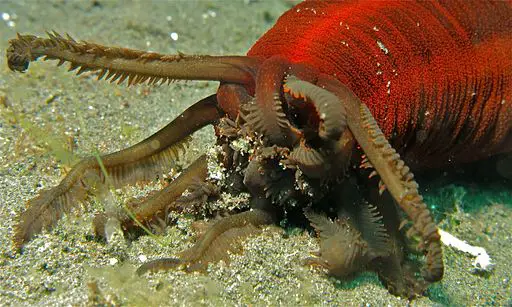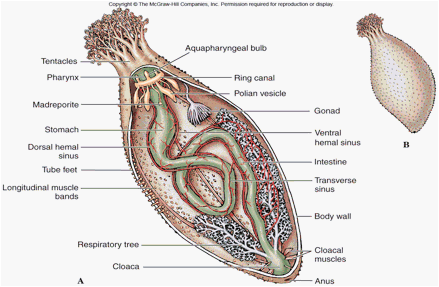How Do Sea Cucumbers Eat?
Sea cucumbers are definitely one of the strangest and possibly most fascinating members of the phylum Echinodermata. Their shape and size are similar to a large cucumber but the similarity to a vegetable ends there. If you’d like to learn more about these animals and wonder how sea cucumbers eat, in this post, we’ll talk all about that. However, let’s begin with a quick answer:
Sea cucumbers have a few ways of eating. Filter feeders expand their feathery tentacles into the water and catch passing food particles. Next, they bring tentacles one by one into their mouth. Sediment feeders use their tentacles to sift through the sand, looking for food and capturing it directly.
However, this certainly doesn’t tell the whole story. Below I’ll explain the way how sea cucumbers eat and their digestive system. Furthermore, I’ll explain what they eat and what animals eat them. Read on!
How do sea cucumbers eat? (Explained)
Sea cucumbers can detect food with the sensitive tentacles that surround their mouth. Interestingly, if the animal is disturbed, it retracts them quickly. They usually have 10 or 30 tentacles which they use to capture food, but there are a few different ways in which sea cucumbers eat.
The filter feeders have bigger and feather-like tentacles. They extend them into a water column and patiently wait for plankton to land and get trapped. Next, they bend and bring one tentacle at a time into the centrally located mouth opening. Some species bury themselves in the sand and leave their tentacles extended.
In the video below you can see how the sea cucumber is “licking” its feather-like tentacles:
Other species of sea cucumbers are sediment feeders and use their tentacles to sift through the sand, looking for particles and capturing them directly. During the process, they usually eat a bunch of sand which passes through their digestive system. See the picture below to see the difference in tentacles between filter and sediment feeders:


Interestingly, by filtering sediments and recycling nutrients back to the environment, sea cucumbers play a significant role in the seabed’s biological processing. After they break down the organic matter, the nutrients are available for smaller animals called primary producers.
Another interesting fact about these creatures is that sea cucumbers stop feeding and slow down their metabolism when there’s little or no food to consume. Another surprising way of surviving when no food is around is that they can eat themselves, gradually becoming smaller and smaller.
Sea cucumber digestive system
Let’s now take a closer look at the complete digestive system of sea cucumbers. It contains the mouth, pharynx, esophagus, stomach, intestine, cloaca, and anus.

The first part of the digestive system is the mouth. It’s located in the center of the head area and surrounded by a ring of modified tube feet – tentacles. Surprisingly, they don’t have teeth in their mouth but in their anus, which we’ll discuss later.
The second part of the digestive system is the pharynx. It’s a short segment located right behind the mouth and surrounded by a calcareous ring. In most sea cucumbers, the pharynx is the only substantial part of the skeleton and is the point of muscle attachment that can pull the tentacles into the body for safety.
The esophagus is a continuous tube that begins at the mouth, connects to the stomach, and is attached to a longer tube called the intestine. The intestine is typically long and coiled and loops through the body three times before connecting with a swollen cloaca or directly with the anus.
The cloaca opens externally through the anus and also contracts regularly to propel water into respiratory structures called respiratory trees.
Anus surprisingly plays a very important role in sea cucumber life. It’s not only a place where sea cucumbers expel their waste but also breathe through it. They also expel toxins and their organs through the anus when feeling threatened and can grow them back after.
Another function of the anus is a shelter for small fish. Pearlfish often live inside them, and because sea cucumbers don’t have a lot of predators, it’s a great hiding spot for them (even though it sounds pretty gross). Some sea cucumbers don’t appreciate that, so they have developed “anal teeth” to keep pearlfish out.
What do sea cucumbers eat?
Sea cucumbers are scavengers, meaning they consume dead animals from the seafloor. The diet of most sea cucumbers consists of plankton, algae, and decaying organic matter. Some will also eat seagrass but in general, it’s not their primary food source.
These creatures live in all ocean areas, so their diet can vary and depend on conditions and migration patterns. Because of their diet, they’re classified as decomposers, meaning they break down dead or decay organisms and carry out the decomposition process.
When do sea cucumbers eat?
Sea cucumbers are nocturnal, meaning they are the most active at night when it’s much safer for them to crawl around without being noticed by predators. During this time, they graze on detritus on rocks and sea bed sediments like a little vacuum cleaner.
Another reason for staying up at night might be actually the fact that some sea cucumbers’ predators such as crabs or starfish are also nocturnal. It might be a good idea for them to stay awake and be ready to release their toxins if needed.
Interestingly, sea cucumbers don’t have eyes so the darkness isn’t a problem for them. They also don’t have any obvious sense organs but they do have a nervous system that allows them to sense the light and dark.
What animals eat sea cucumbers?
As you may already be thinking, sea cucumbers don’t look tasty to many marine animals, plus they have an effective defense system. However, of course, they have a few predators that can handle sea cucumber toxins. One of them is a Giant Sun Star in the North Pacific that directly digests its prey.
Read more about it in my other blog post: “Top 10 Predators Of Sea Cucumbers”.
In the South Pacific, a large snail called Partridge Tun finds sea cucumbers delicious and uses a powerful venom that subdues its victims. Other sea cucumber predators are tigerfish, crabs, putter fish, lobsters, sea turtles, and some shark species.
Sources:
- Filter feeder’s tentacles image: Peter Southwood, CC BY-SA 3.0 https://creativecommons.org/licenses/by-sa/3.0, via Wikimedia Commons
- Sediment feeder’s tentacles image: Bernard DUPONT from FRANCE, CC BY-SA 2.0 https://creativecommons.org/licenses/by-sa/2.0, via Wikimedia Commons
You may also like:

Welcome to Bubbly Diver!
I’m glad to see you here. This blog is created for all marine creature lovers by a bubbly diver - me, Dori :)


